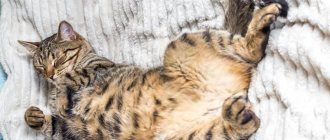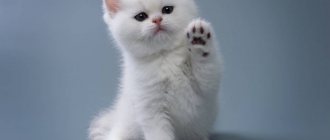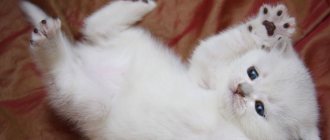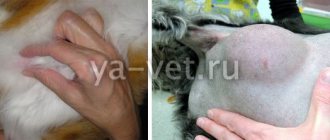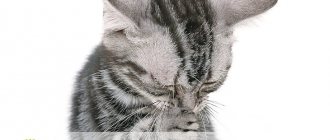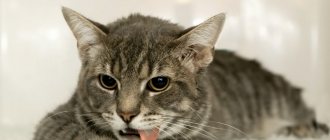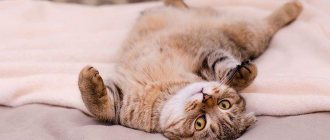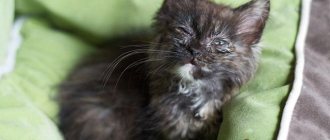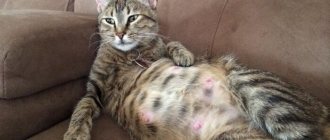9956Pavel
When a cat has a hard stomach, it is necessary to urgently take the animal to a veterinarian. Delay in treatment can lead to the death of your pet. If there is a hard lump in the stomach, then this is also a reason to visit a specialist. The phenomenon may indicate the presence of a tumor or intestinal blockage. Both are extremely dangerous.
Hardness causes tension in the abdominal muscles, which is unnatural. Very often, in addition to this, the cat experiences bloating and other gastrointestinal disorders.
© shutterstock
Breed characteristics
Some breeds have a fold in the abdominal area their entire life. And, by the way, there is nothing reprehensible in this, since natural affiliation simply obliges you to “possess” a fat tail.
Do not be upset if the skin hangs on the belly of a cat of the following breeds: Canadian Sphynx, Pixie-Bob, Bengal, Scottish Straight, Scottish Shorthair. The reasons for the presence of loose skin in pets of these breeds are unknown. Probably, the fat layer should protect short-haired and hairless individuals from the cold, and for others, the fat tail should protect the abdominal organs from injury during fights.
Important! You should not try to reduce a saggy belly by starving your pet. With such a diet, the skin will not go anywhere, but, on the contrary, will become even more noticeable on a body that is too thin
Natural cause
A cat may have a tight belly for natural reasons. So, in late pregnancy, due to a serious enlargement of the uterus, tension in the peritoneal muscles occurs. This phenomenon is necessary to prevent injury to the kittens. In this case, the cat does not require treatment, since this condition is natural.
The abdominal wall becomes especially hard before lambing, since at this moment all the muscles begin to tense, preparing the body for the birth of kittens. After their birth, the abdomen may remain hard for several hours, thus causing muscle spasm, which is a consequence of severe overload.
Diagnostics and therapy
To make a diagnosis, blood, urine and feces are examined, ultrasound and x-rays are done. During the examination, the veterinarian palpates and listens to the peritoneum. Depending on the results that explain why the cat has a hard stomach, the doctor decides what to do to normalize his condition.
Help with non-dangerous causes of bloating
Flatulence caused by poor nutrition can be eliminated by adjusting the diet. A ban is imposed on any products that increase gas formation (legumes, flour, fresh vegetables). Remember that milk is contraindicated for adult animals, as they develop lactose intolerance. To normalize intestinal function, your veterinarian may recommend a course of probiotics.
Read also: How long does the smell of fumes last?
Excessive weight can be eliminated by reviewing your diet. The animal is prescribed less high-calorie food and the usual portions are reduced. Daily physical activity is complemented by joint games.
A big belly in a scared cat can be healed with time. Do not impose your affection and let your pet get used to the unfamiliar environment.
Treatment of the underlying disease
Surgery will be required to eliminate pyometra. During the operation, the veterinarian cuts out the uterus, that is, performs sterilization. Surgeries are also necessary to remove a tumor, intestinal obstruction, foreign object, or the consequences of severe trauma.
Mastopathy
Mastopathy or mammary hyperplasia is a benign tumor. It gives the cat unpleasant and painful sensations. Represented by permanent changes in the mammary glands. These include neoplasms and other pathological processes.
Bumps on a cat's body are detected by palpation. They feel slightly elastic to the touch. There is a high probability of their occurrence in animals over 7 years of age.
Forms of the disease
Breast hyperplasia is divided into two forms:
- Diffuse mastopathy. Manifests itself with painful sensations before estrus. It feels like a bag of fine shot. Often goes into the next form.
- Fibrocystic mastopathy. The disease is represented by compacted nodules in the area of the mammary glands. They cause the cat discomfort and pain. Such bumps can form in a cat aged 10–16 years.
Causes
The appearance of the disease in cats is provoked by:
- mastitis is a common precursor;
- injury to the mammary glands;
- hormonal surges that were caused by estrus, pregnancy and nursing;
- prolonged stressful situations;
- feeding with low-quality feed;
- nematode larvae, which often live in the mammary glands.
Symptoms
The resulting mastopathy, which looks like a lump on a cat, manifests itself with the following symptoms:
- Colostrum discharge from the nipples mixed with blood or ichor.
- Pain in the mammary glands. They cause discomfort to the cat, which is noticeable by frequent licking.
- Enlarged glands. On palpation, fine granularity or veininess is felt.
- General deterioration in health. The cat loses its appetite and becomes very thirsty.
- Enlarged lymph nodes.
Important! In some cases, mastopathy manifests itself as ulcers, wounds and suppuration.
Diagnosis of pathology
If a cat has a lump in the lower abdomen, it is examined. It involves taking blood for biochemical and clinical analysis. Ultrasound and x-ray are recommended to exclude the presence of metastases in the abdominal cavity and lungs.
To determine the tumor group, a histological examination is performed. If mastopathy is confirmed, the veterinarian recommends a mastectomy, a surgical procedure to remove the affected glands.
Treatment and prevention
If a lump under the skin is detected at an early stage, homeopathic remedies and medications may be prescribed.
Important! There is an erroneous and even dangerous opinion that mammary hyperplasia can be treated with compresses. In fact, this leads to tumor degeneration.
In other cases, mastopathy is treated with mastectomy. The operation is performed by a surgeon. It involves removing the ball under the skin, the affected mammary glands and lymph nodes. Upon completion of the procedure, the animal is prescribed antibacterial therapy and special postoperative care.
Sterilizing the kitten before the onset of the first heat will allow you to 100% avoid mastopathy. Other activities are aimed at early detection of the disease. These include:
- visit the veterinarian 3–4 times a year;
- refusal of hormonal drugs to suppress estrus;
- selection of high-quality industrial feeds.
Diagnostics
Diagnosis of bloating must be comprehensive and include blood tests (general and biochemical), urine, abdominal ultrasound and x-rays. In some cases, especially if neoplasms are suspected, a CT scan is recommended.
The following are the primary diagnostic methods, depending on the suspicion of various causes of bloating:
- Obesity – weighing the pet, analyzing the diet, palpation;
- Pregnancy - ultrasound of the abdominal cavity;
- Flatulence - diet analysis, abdominal ultrasound;
- Viral disease - specific virological tests (PCR test of blood and effusion);
- Neoplasm – ultrasound of the abdominal cavity, plain X-ray in three projections, CT in the “oncology search” mode;
- Heart diseases – cardiac ECHO;
- Liver diseases - general and biochemical blood tests, ultrasound of the abdominal cavity;
- Kidney diseases - general and biochemical blood tests, abdominal ultrasound, urinalysis;
- Coprostasis – abdominal x-ray;
- Injuries – ultrasound of the abdominal cavity;
- Pyometra - ultrasound of the abdominal cavity;
- Helminthic infestation - stool analysis.
Signs of pathology
A cat's enlarged belly should be the reason for an unscheduled visit to the veterinarian. Sometimes, if the outflow of urine is disrupted or the intestines are blocked, a timely operation can save the life of a pet.
Why do certain pathologies develop if, in the opinion of the owners, the animal is well cared for? The causes of the development of diseases accompanied by enlargement of the peritoneum are:
- poor nutrition, lack of animal access to water;
- non-compliance with the schedule of vaccination and anthelmintic measures;
- peritoneal injuries;
- development of chronic diseases of internal organs.
There are a number of symptoms, the occurrence of which requires urgent consultation with a veterinarian. These include:
- diarrhea;
- vomit;
- apathy;
- increase in body temperature (hot, dry nose and ears);
- lack of appetite;
- the presence of blood, parasites and their eggs in the stool or urine.
Symptoms indicating illness
In addition to the duration of the bloating, it is important to consider any warning signs. Possible pathology is indicated by:
- inflammation, yellowing or blue discoloration of mucous membranes;
- too rapid enlargement of the peritoneum or sudden weight loss;
- frequent vomiting, diarrhea, or lack of bowel movements for more than 2 days in a row;
- lethargy and fever;
- pain when emptying the bowel or bladder;
- dullness and hair loss;
- foam, blood or parasites found in vomit and feces;
- increased thirst and loss of appetite;
- profuse drooling;
- severe pain in the abdominal area upon palpation.
If a pregnant cat's swollen belly does not return to normal within 1.5 days after birth, call a veterinarian. This condition is typical for unfinished labor. The stuck fetus will have to be removed surgically.
What is a cat's fat tail?
A cat's fat tail is scientifically called a “primordial pouch,” which means a genetic tendency in some cat breeds to form a fold of skin on the abdomen, between the hind legs.
A small hanging tail is considered normal for cats if it is elastic, soft to the touch, does not cause pain and its size does not exceed 5 cm.
In felinology, there are several theories that explain this anatomical feature in cats:
- The inguinal skin fold is a “depot” for fat deposits, which are consumed during prolonged fasting of a cat, which allows animals to survive in the most difficult circumstances. Fat deposits in cats are especially noticeable during the winter cold.
- The fat tail acts as a repository of excess elastic skin, which is actively used when jumping high, long, while climbing trees or when entering narrow crevices, when the cat needs to stretch out “in line” to get to the desired place.
- A hanging belly in cats is an additional means of protecting internal organs during fights and fights with relatives. Cats tend to deliver powerful blows to the enemy with their hind legs, and an additional layer of skin will protect the vulnerable belly from damage to internal organs.
All domestic and wild cats have a fat tail, but in some it is more pronounced due to breed or physiological characteristics, in others it is less pronounced.
In spring and summer, the size of the saggy tummy in cats is significantly reduced, and in late autumn and winter the fat tail grows again.
Other factors
It has also been noticed that in older cats (over 10 years old), the collagen fibers in the subcutaneous layer become thinner, the elasticity and turgor of the skin decrease, which is why fat tail appears very often.
Veterinary nutritionists, when prescribing a cat to “lose excess weight,” also often note an increase in the inguinal fold in patients who have lost weight. Especially if the process was intense and was accompanied not only by a transition to dietary nutrition, but also by an increase in exercise.
If the cat has lost a lot of weight and a bag of skin appears in the lower abdomen (while the diet has not changed), then a possible cause may be the progression of chronic diseases (pancreatitis, hepatitis, malignant neoplasms).
What to do:
- in all cases of abdominal enlargement, it is necessary to consult a doctor, regardless of the age of the animal - there are no options for “it will resolve on its own”!
– the faster the belly enlarges, the more urgent it should be to see a doctor. If there is a simultaneous significant deterioration in your health, you must go immediately to the clinic, where an ultrasound/X-ray and, if necessary, surgery can be performed.
– to independently monitor the amount of fluid in the abdominal cavity, you can use weighing + measuring the volume of the abdomen with a centimeter tape. Nevertheless, primary importance when choosing treatment tactics is given to the general condition of the animal and the degree of tension in the abdominal wall, and not to weight/volume.
Can ascites in cats be treated or not?
Treatment of ascites is carried out comprehensively. Therapy is aimed at eliminating the underlying disease, alleviating pain symptoms and strengthening the immune system.
To reduce the amount of fluid in the abdominal cavity, laxatives and diuretics (Furosemide, Temisal) are indicated.
To stabilize the functioning of the cardiovascular system, drugs such as Olitorizide, Strophanthin, Digitoxin, Cardiovalen are necessarily prescribed.
If there is an infection in the body, antibiotic therapy using drugs from a number of cephalosporins is indicated.
To strengthen the walls of blood vessels and reduce their permeability, the veterinarian prescribes intravenous solutions of calcium chloride (10%).
To pump out the fluid, a puncture is done when the veterinarian pierces the abdominal wall. The procedure is performed at least twice a week. In this case, the removal of ascitic fluid must be compensated by reinfusion of ascitic transudate or administration of an albumin solution. These procedures provide a chance for additional remission and prolongation of the animal’s life.
The course of treatment depends on the condition of the animal and the amount of fluid. This is a long process that must continue until the clinical signs of dropsy completely disappear.
As for the prognosis, with adequate and, most importantly, timely therapy, it is favorable. If you do not seek help from a specialist in time, the volume of fluid will continue to increase, and this is fraught with pressure on the internal organs and disruption of their functions.
Treatment
Treatment can be conservative or surgical. This will depend on the cause of the hard belly syndrome. For example, in case of helminthic infestation, it will be necessary to carry out specific antiparasitic therapy; in case of constipation, a special diet and mild laxatives will be required. Antispasmodics are often recommended as symptomatic therapy. These remedies help relax the muscles of the abdominal wall, but can neutralize many symptoms and complicate diagnosis. Therefore, it is better for the veterinarian to show the animal before trying to help it. The most competent method of first aid would be to provide the animal with rest and deliver it to a veterinary hospital.
Symptoms of ascites
The first and most obvious signs of ascites are the following symptoms:
- swollen, tight stomach (“bulging” sides);
- poor appetite (sometimes complete refusal to eat);
- flatulence, constipation, diarrhea;
- vomiting (most often with saliva);
- depressed mood (anxiety, sadness, apathy, etc.) due to abdominal pain;
- heavy breathing (rapid breathing, with wheezing, groaning, coughing, etc.);
- the cat tries to lie on its side;
- caution in movements (slow gait, uncertain steps, etc.);
- refusal to play and fatigue;
- weakness (fainting is also possible).
Some owners may mistake dropsy for the first signs of pregnancy (in cats), helminthic infestation, or flatulence. To make sure that it is definitely not gases or a fetus, it is enough to take the sick cat in your arms. In an animal in an upright position, the fluid will flow into the lower abdomen. As soon as you place the cat on the floor, the water will again be distributed throughout the abdomen.
Photo gallery: some signs of ascites in cats
With ascites, the cat's stomach "swells" A sick cat may become apathetic or aggressive If ascites, a cat may have diarrhea or, conversely, constipation Cats with dropsy do not eat well, sometimes completely refuse to eat A sick cat may cough or have difficulty breathing
It is important to recognize dropsy immediately and contact a veterinarian, because time may not be in your favor. For example, in cats with diabetes, the volume of fluid can reach 2-3 liters (the larger the cat, the more fluid) in just 2-3 days.
When a hanging belly is normal
When the belly does not hang much, the cat’s health is normal, then there is no need to worry. In most cases, fat tail is a feature of the body associated with age, physiological changes, and breed predisposition.
| sudden weight loss | proper diet and physical activity force an obese cat to quickly lose weight, and a hanging belly remains a reminder of its former fatness, which gradually tightens in young cats; but if weight loss is not related to diet, and your pet develops suspicious symptoms, contact your veterinarian immediately |
| multiple or large pregnancy | when carrying 8-10 babies or producing large fetuses, the stretched uterus causes the abdominal walls to expand; the belly can sag during normal pregnancy, if the female has a miniature build; a predisposition to multiple pregnancies is a desirable feature of breeding cats; breeders prefer to breed females with a noticeable fat tail |
| castration | deprivation of reproductive ability is a serious blow to hormonal levels; a neutered pet becomes gluttonous, less physically active, and gains extra pounds, leading to a sagging belly |
| aging | in older cats, the synthesis of collagen fibers inevitably decreases, the skin loses its elasticity, gradually stretches downwards, as a result, the fat tail becomes more noticeable |
| breed feature | a noticeably hanging belly is the norm for the Canadian Sphynx, Bengal, British, Pixie Bob, Canaan, Straight-eared Scots, Chausie, Savannah, Cornish Rex, the listed breeds are closely related to wild relatives, passing on the external feature to their descendants; In Scots of the American line, the fat tail is unexpressed, since aboriginal cats with a similar feature were used for breeding, and in European individuals, the pouch is noticeable even in a kitten, because the ancestor is a British cat |
How to determine the cause of a bloated belly
In most cases, an increase in the size of a kitten's belly is not a sign of serious pathologies. You can try to determine the cause of a bloated belly yourself:
- When the problem is related to errors in nutrition, namely overeating or feeding age-inappropriate food, the kitten experiences bloating.
This occurs due to pressure on the walls of the intestines and peritoneum of gases that were formed due to malfunctions in the baby’s digestive system. In other words, the kitten is worried about flatulence. It's very easy to check - just lightly tap your stomach with your fingertips. If at the same time a dull sound occurs (as if from a “barrel”), then this indicates flatulence. You can also often feel and hear a rumbling sound when you put your hand on the kitten’s tummy. Most often, a kitten's bloated belly is caused by errors in nutrition. - With constipation, you can note that the kitten does not go to the toilet for a long time to empty its intestines (more than a day), meows pitifully and is worried.
- Worm infestations accompanying a pet's swollen tummy cannot be determined without an appropriate analysis performed by a veterinarian (except for cases where worms are visible to the naked eye in the animal's excrement, which indicates a massive infection). Therefore, in cases where the kitten’s nutrition is organized at the proper level and there is no reason to believe that flatulence is the cause of the illness, the animal should be shown to a veterinarian.
- Internal diseases, which, among other things, lead to bloating in kittens, have a whole range of other symptoms by which they can be diagnosed. However, this should be done by a professional - a veterinarian.
Bloating in kittens is often accompanied by the following conditions:
- diarrhea - observed with poor nutrition and helminth infection;
- vomiting - one-time can be associated with overeating, repeated - with a wide range of diseases of the digestive tract, including helminthic infestations;
- unpleasant color and smell of feces - may indicate infectious diseases or helminthic infestations;
- changes in taste preferences and feeding habits - eating inedible objects, an unusually strong appetite may indicate that the kitten is not getting the vitamins and microelements it needs from food;
- elevated body temperature, lethargy, apathy - as a rule, indicate food toxic infections or inflammatory diseases of internal organs, for example, peritonitis.
Reasons why a cat's tummy is swollen
Bloat can happen for many reasons, and some of them can be life-threatening for your pet.
Poor nutrition and gases
A kitten's belly may become bloated due to certain foods. Often, flatulence (accumulation of gases in the intestines) results from feeding your pet milk and dairy products (especially for adult animals).
Constipation
Constipation is an accumulation of stool that becomes dry and hard and cannot be passed out on its own. This leads to intoxication of the body, and gases begin to accumulate in the intestines, which cause bloating.
Constipation occurs for many reasons:
- incorrectly composed diet;
- intestinal obstruction;
- accumulation of wool in the stomach;
- congenital anomalies;
- obesity and inactivity.
Constipation may cause bloating in cats
Swollen intestines from worms
Parasites actively multiply in the pet’s intestines and cause intoxication. Along with bloating, the cat also experiences other symptoms: vomiting, bowel irregularities, and the presence of worms in the feces. Moreover, the cat may be thin, but with a bloated intestine.
The animal eats a lot
Cats that eat very greedily and eat a lot often suffer from flatulence. At the same time, they swallow food without chewing it, which leads to large amounts of air entering the intestines and stomach. As a result, the intestines can swell to incredible sizes. Usually the animals themselves who live in shelters or nurseries eat so greedily.
Overeating leads to bloating in animals
Diseases of internal organs
Enlarged intestines can be a symptom of serious diseases of the internal organs:
- Pyometra. With this disease, pus accumulates in the cat's uterus, which is accompanied by an enlargement of the abdominal cavity. Associated symptoms: depression, fever (not always present), discharge from the loop.
- Peritonitis. An enlarged abdomen or ascites (accumulation of fluid in the abdominal cavity) accompanies the wet form of coronavirus infection (FIP).
- Tumors. The volume of the abdomen may increase significantly due to a malignant tumor in the abdominal cavity.
Clinical picture
The initial stage of the pathological condition is virtually asymptomatic, since the accumulation of fluid in the abdominal cavity is a gradual process. Characteristic signs can only be noticed when the volume of fluid significantly exceeds normal levels. Ascites can be suspected by a noticeably swollen abdomen and stretching of the sides when the animal is active.
Symptoms:
- the abdominal cavity is swollen, hard to the touch;
- fluctuation - when pressing on the abdomen, you can feel the liquid inside it swaying;
- the belly takes on the shape of a pear when the cat stands on its hind legs, and inflates and rounds when taking a sitting position;
- dullness and disheveled fur;
- yellowish tint of mucous membranes;
- paws, ears, crotch, sternum swell;
- vomiting, nausea;
- lack of appetite;
- constipation or diarrhea;
- breathing problems, hoarseness, shortness of breath;
- weakness, apathy.
It is very important to distinguish ascites from ordinary overeating.
In what cases should you contact a veterinarian?
The most dangerous causes of an enlarged abdomen in a kitten are peritonitis and ascites. Without timely veterinary care, the pet may even die. How to recognize these dangerous pathologies:
- Peritonitis is an inflammation of the abdominal cavity of an animal. It is necessarily accompanied by the following symptoms: elevated body temperature;
- vomiting;
- refusal of food;
- weakness;
- apathy.
Peritonitis and ascites are life-threatening conditions, so you need to take the kitten to the vet as soon as possible. Only a specialist can treat these pathologies, and sometimes even minutes count.
Bloating in kittens
When purchasing a kitten, always inspect its tummy. In a healthy animal it should be soft and small. A temporary increase may occur after a recent feeding or shortly before going to the toilet.
If a healthy baby's tummy becomes the size of a balloon or a pear, be sure to worm your pet and take him to the vet. Anti-parasite tablets are given at intervals of 2 weeks. At the first ingestion, all adult individuals die, and at the second, the remaining eggs, which have evolved into adult worms, die.
